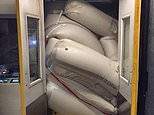
Emergency slides are installed on planes to save lives – but they deploy with such force that they could take one away.
This fact is never lost on cabin crew, with former flight attendant Jay Roberts revealing to MailOnline Travel that accidentally activating an emergency slide ‘is a mistake that flight attendants and airport staff worldwide dread, causing so much anxiety we have nightmares about doing it’.
Jay, who has worked as senior cabin crew for Emirates and who runs the popular Fly Guy’s Cabin Crew Lounge network, said: ‘Even with several checks and balances involving more than one person to ensure the slides don’t open accidentally, mishaps still happen, and at larger airlines, they happen several times a year and cost airlines tens of thousands to repack. In addition to being costly and causing great embarrassment among colleagues, being known as that crew who “blew a slide”, the mistake poses a real danger to safety.
‘No matter its size, a plane must be able to be evacuated in 90 seconds or less. Every second counts, which is why the emergency slides deploy with enough pressure to go fully inflated in a matter of seconds.
‘That force can cause a deadly blow to someone standing in its way and not expecting its deployment.
Emergency slides are installed on planes to save lives – but they deploy with such force that they could kill someone. Occasionally, they are deployed by accident (above)
Jay Roberts (above) – who has worked as senior cabin crew for Emirates and who runs the popular Fly Guy’s Cabin Crew Lounge network – said the fear of accidentally activating an emergency slide ‘is a mistake that flight attendants and airport staff worldwide dread, causing so much anxiety we have nightmares about doing it’
‘While I don’t know of an incident where someone has died due to being crushed by a slide, there have been times when it came close. In 2013, Asiana Flight 214 crashed on landing at San Francisco International Airport in California. The impact force caused two of the eight slides to inflight inwards trapping two flight attendants at their stations beside the exits. One of the flight attendants was reported to be choking to death from the pressure and was saved by the quick action of a senior crew member who used a cabin emergency axe to deflate the side.
‘Due to this safety risk, most modern aircraft exit slides are designed to disarm automatically when opened from the outside.
‘What’s more, whether the airline’s procedure calls for the door to be opened by the ground staff outside the plane or the flight attendants, all airlines will have a slide-disarming process at the end of every flight to minimize the risk of accidental slide deployment. When you pull into the gate, you will always hear an announcement like “cabin crew prepare for arrival and stand by for all call”.
‘After this PA, the crew are released from their jumpseats and they disarm their doors. If they are on a plane large enough to have other crew stations, they will visually or physically check that their colleagues in the neighbouring station have also disarmed their door.
‘On modern aircraft, the lead flight attendant will check a screen at the forward left side door to see if the slide status has changed from armed to disarmed. That crew member will then call all the flight attendant stations to recheck the slides verbally.
Jay said: ‘No matter its size, a plane must be able to be evacuated in 90 seconds or less. Every second counts, which is why the emergency slides deploy with enough pressure to go fully inflated in a matter of seconds’
‘Each crew member will say their station location followed by the confirmation “disarmed and crosschecked”. Then the lead crew member will announce: “Clear to open doors.”
‘Following this, the crew member will still follow strict procedures to begin the opening process. You could not open the door at my former airline without a senior crew member called “the checker” behind you. You would look at the disarming lever and confirm it was disarmed with the words “door disarmed”. The checker would then reconfirm, saying, “Door disarmed – you are clear to open.” This was followed by slowly opening the door while watching for warning lights to indicate the door was still attached to the arming mechanism.’
Jay revealed that in addition, ground staff are trained on disarming the doors from the outside, with the most essential step being to ‘step to the side or back as the door opens in case the slide inflates’.
Jay said: ‘At my previous airline, the ground staff would give a thumbs up to the crew through the window, indicating it was safe to open the door, then they would step back and wait for us to open, giving themselves an escape in case the slide blew out of its hold.’
The former flight attendant remarked that even with all these procedures in place – ‘accidents happen’.
He continued: ‘When you see photos or videos of slides deployed in the media, they are most commonly a result of crew oversights, older aircraft with manual disarming procedures, equipment malfunctions, or a passenger opening the exits on the ground.
‘In my experience, inadvertent slide deployment was often caused by crew fatigue. For example, at my former airline, we operated many long night flights, and it was the airline’s procedure that all doors were to be opened by the crew when they were on board. Generally, the slide deployments happened after these night flights.
‘I remember one incident where the junior crew member disarmed their door, walked to the opposite exit to check their colleague had disarmed their door, came back to their exit, which had been verified by a checker to be disarmed, opened the arming lever guard and rearmed the door, ignored the warning lights that activate as you start to open the door in the armed mode, and blew the slide on opening.
Jay said: ‘When you see photos or videos of slides deployed in the media, they are most commonly a result of crew oversights, older aircraft with manual disarming procedures, equipment malfunctions, or a passenger opening the exits on the ground’
‘The result of a slide activation on passengers is often a long delay or flight cancellation. If the aircraft was operating an active flight, a new slide must be attached, which can take time to source and install. If one is unavailable, the aircraft can still operate. However, procedures typically require passengers to be moved from that area around the inoperative door, and if the flight is full, the number of passengers has to be reduced, meaning you could be kicked off the flight.
‘Emergency slides are vital to commercial aviation and save thousands of lives annually. They are highly respected safety tools, and for those that get the rare chance to use them, the incident is an occurrence that goes down in their career history books and often goes on to become an airline legend. Aviation safety is a system based on trial and error, with each incident being used as a case study to learn and improve from. Each slide activation is investigated, and the data is used to form better procedures and airplane components to protect profits and people better.’
For more from Jay visit www.instagram.com/aflyguytravels and www.facebook.com/aflyguyslounge.
Source link
CHECK OUT: Top Travel Destinations
READ MORE: Travel News



